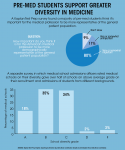This post was updated April 23 at 6 p,m.
Pre-medical students support greater diversity in the medical profession, according to a recent national survey.
The survey, which was published April 15 by Kaplan Test Prep, found that 80% of pre-medical students said the medical profession needs to better reflect the demographics of the general patient population.
Representation of minority groups in medical schools has not mirrored that of the patient population, said Petros Minasi, director of pre-health programs at Kaplan.
About 4% of active physicians in the United States are black and another 4% are Hispanic, while black and Hispanic patients each make up 13% of the patient population, Minasi said.
Minasi said the number of African Americans entering medical school has declined in recent years. In 1978, 1,410 African American men entered medical school nationwide, while in 2015, only 1,337 entered medical school, according to the Association of American Medical Colleges, Minasi said.
Minasi said this disproportional representation is caused by the high cost of tuition at medical schools and the exclusive culture of pre-health programs. In addition, many students are not aware of the programs and services universities provide, he added.
Mitchell Chang, a UCLA education and Asian American studies professor who specializes in diversity, said the underrepresentation of African American men in medical schools is a result of Proposition 209, a state law voted into effect in 1996.
The proposition banned UCLA from factoring race into the admission process. After the law came into effect, UCLA saw a steep decline in the number of African American and Latino students it admitted and enrolled, Chang said.
Chang said UCLA had made steady progress in enrolling minority groups until the proposition came into effect.
He said this is due to educational inequalities before college that limit opportunities for minority populations.
“K-12 education is deeply unequal in ways that disadvantage minority populations because those populations live in more challenging economic environments with underresourced schools,” Chang said.
Chang said students, especially minority students, tend to be discouraged from continuing with pre-med programs if they don’t do well in introductory science courses.
Chang added universities should better support their undergraduates through mentorship, tutoring and writing programs to combat the issue of low retention in pre-med programs.
He also said he thinks UCLA needs to develop stronger community ties, especially with communities that have low enrollment numbers at the UC.
“The problem goes way back. (Students from underserved communities) don’t think that UC education is really available to them because they don’t see anybody from their high schools going to UCLA,” Chang said. “Even though there’s great talent there, they don’t even apply to UCLA.”
The lawmakers behind Proposition 209 analyzed student demographics in California and found communities that have not sent as many high school graduates to the UC are often challenged financially.
“We have to make sure that they are well prepared to succeed in this university, and once they get here, we need to have a stronger commitment to them for them to succeed,” Chang said.
Clarence Braddock, the vice dean for education at the David Geffen School of Medicine, said UCLA has various programs designed to help underprivileged minority groups.
For example, UCLA has an outreach program, two pipeline programs, preparatory programs and a summer health profession education program, which Braddock leads. He said these programs are designed to help undergraduate students prepare for medical school.
“UCLA’s student body composition is one of the most diverse in the country,” Braddock said. “The School of Medicine has a longstanding commitment to diversity and has a strong track record in recruiting students in diverse populations.”
Many colleges are seeking to address deficiencies in the admissions process that contribute to a lack of diversity in medical schools. Data on MCAT exam results have suggested that students do worse on the exam if they come from educationally disadvantageous backgrounds, because they do not have as many resources for test preparation.
Braddock said while the UC does not consider race or ethnicity as a factor in admissions, he thinks the university has been successful in encouraging diversity with its outreach programs.
Siuneh Minassian, a student at the UCLA School of Dentistry, said diversity is important because receiving treatment from medical professionals with similar backgrounds can help patients become more comfortable with clinical procedures.
“Patients often relate to medical professionals that share their cultures, and different cultures often view procedures in different ways. Say, if you needed (a dental) extraction done, it might be a bigger issue if you belong to a more traditional culture,” Minassian said. “Having a doctor that shares your background would make you more comfortable speaking to them about the care you need.”
Medical school administrators can look at the increase of women in medical schools as an indicator that it is possible to create a more diverse student population, Minasi said.
“Demographic shift doesn’t happen overnight. But I think it’s worth noting that for the first time since 2004, more women than men applied to medical schools, and women enrolled in the majority of the matriculants,” Minasi said. “There is progress that has been happening.”

It is the true heart and soul of any academic program.
More one sided news from the libs at the Daily Bruin.. how about graphing the % of non-whites entering the medical field ??… it would split apart your biased narrative since doing that would demonstrate that most students entering the medical field are either Indian and/or Chinese… And most of these students come from very meager means.. somehow they still get into medical school and strive.. One possible explanation for why blacks do not enter the medical field could be that the emphasis is on rapping and athletics.. NOT EVERYTHING IS BLACK OR WHITE